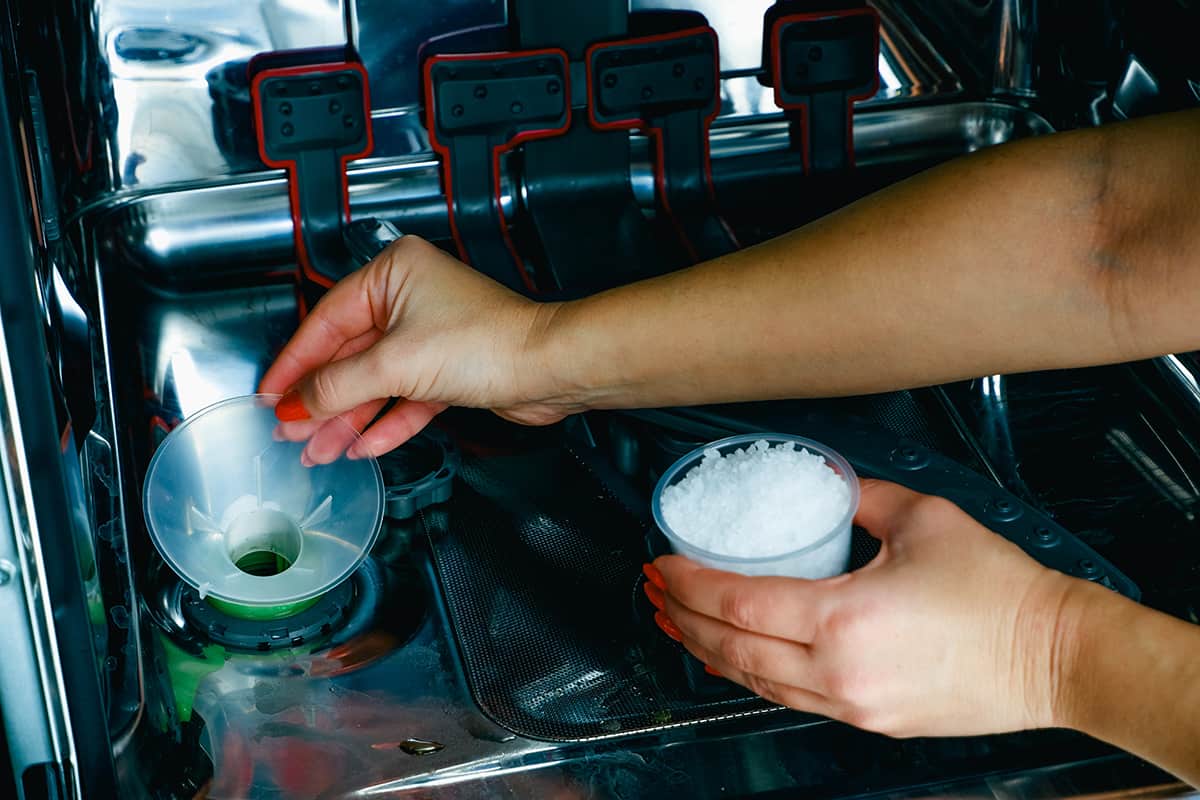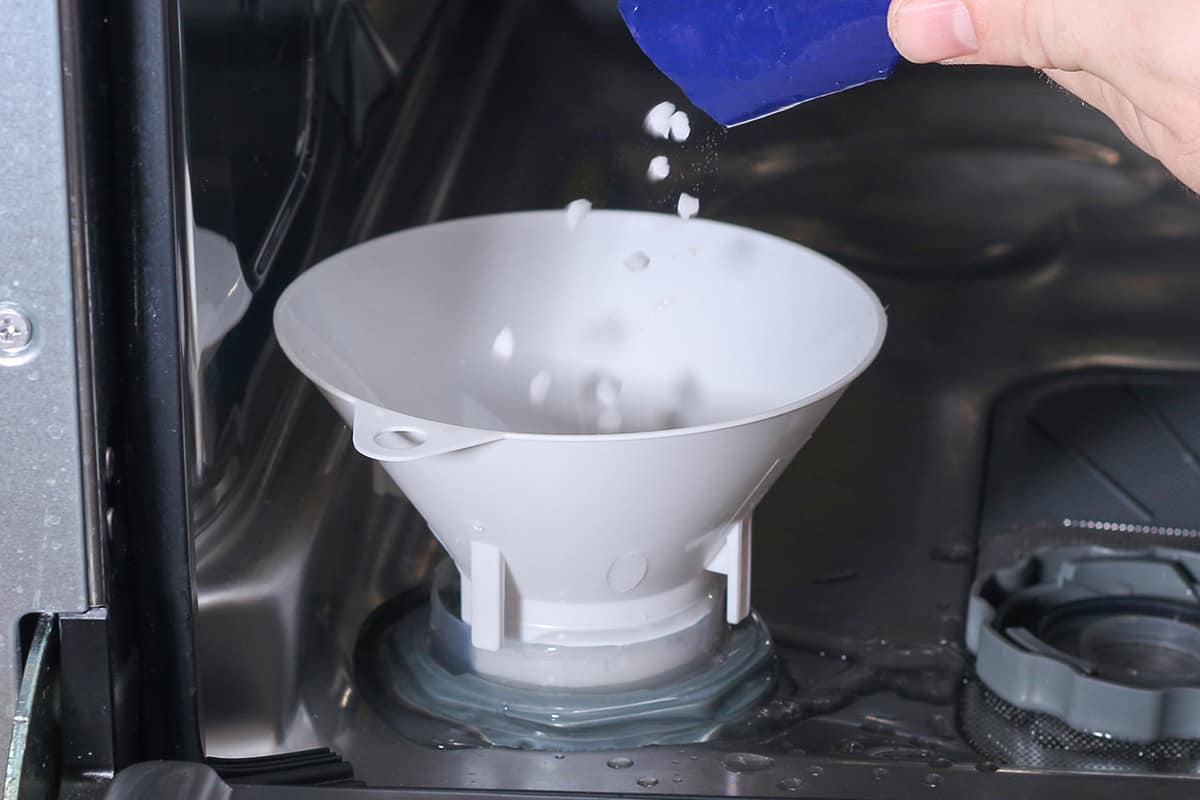The main things people know to put in dishwashers are detergent and, to a lesser extent, rinse aid. However, did you know that your dishwasher might have a salt compartment?
The salt compartment in a dishwasher is usually located at the tub’s base. This compartment is only found in dishwashers with built-in water softeners. Adding dishwasher salt to the salt compartment prevents limescale buildup, which can leave streak marks on your dishes.
In this guide, I’ll explain what dishwasher salt is, how it compares to rinse aid, and how to use dishwasher salt.
What Is Dishwasher Salt?

Dishwasher salt is salt that is made to go into your dishwasher. Unlike traditional table salt, dishwasher salt is coarser in texture, even though it is made of the same elements (sodium and chlorine). The purpose of dishwasher salt is to soften the water from your home’s water supply.
Hard water, which is what the vast majority of homes in the US have access to, is packed with minerals like calcium and magnesium. Over time, the mineral content in the water will cause limescale buildup. If you notice a chalky residue forming around your kitchen and bathroom faucets, then your home is connected to a hard-water supply line.
How Does Dishwasher Salt Work?
Dishwasher salt is practically identical to water softener salt. It works by regenerating ion exchange resins to expel calcium and magnesium ions.
In simple terms, the salt draws the mineral ions out of the hard water, allowing softened water to pass through your dishwasher’s system. The result is streak-free dishes after a completed wash cycle in the dishwasher.
Dishwasher Salt vs. Rinse Aid
Something many of you might know about is rinse aid. Rinse aid, like dishwasher salt, aims to remove streaks from your dishes after a complete cycle. So, what are the differences between them?
First of all, dishwasher salt softens water by trapping minerals in the water. Without the salt, the dried water droplets would leave calcium and magnesium ions all over your dishes.
Rinse aid, on the other hand, adds surfactants to the water. A surfactant is a substance that reduces the surface tension of water, giving it a somewhat hydrophobic effect when it comes into contact with an object.
So, as water droplets make it onto your dishes in a dishwasher, the droplets will immediately fall off the sides of your dishes. When the dishes dry, they will not have the leftover streaks of the water droplets.
How to Use Dishwasher Salt

If you want to add salt to your dishwasher, the first thing you should do is check whether or not your dishwasher has a salt compartment. In the majority of dishwasher models, the salt compartment should be located at the bottom of the base.
To access the salt compartment (also known as the water softener), carefully pull out or remove the bottom dishrack. Look for a circular cap located on the far-back corner of the tub. If you don’t see a cap, contact the manufacturer and ask where the salt compartment is. For the most part, if you don’t see the cap on the floor of the dishwasher tub, your dishwasher doesn’t have a salt compartment.
After locating the salt compartment cap, here’s what you need to do:
If this is the first time you are using the water softener in your dishwasher, pour water into the water softener. Remove the cap and, using a cup with a spout or a funnel, add water to the water softener until the water reaches the top of the opening.
Add salt to the water softener. Using the included scoop and a funnel, carefully pour salt into the water softener. Follow the instructions on the packaging to see how much you should put into the dishwasher’s water softener.
Use a damp cloth to get rid of the spilled dishwasher salt. It’s important that you never put salt directly into your dishwasher. You can also spray water into the dishwasher to push the salt into the dishwasher’s drain.
If the salt touches metal cutlery or cookware, it could cause them to rust. Dishwasher salt may even cut through the chromium oxide layer, causing the metal to rust. When you’re done cleaning up the spilled dishwasher salt, screw the water softener’s cap back into place.
Start a wash cycle as you normally would. Carefully replace the bottom dishrack and load the dishwasher with dirty dishes. When you activate a wash cycle, the water that enters the dishwasher will pass through the water softener, so all of the calcium and magnesium ions will be absorbed into the salt.
Do You Need to Add Dishwasher Salt to Your Dishwasher?

Now that you know where the salt compartment is and how to use it, should you use it at all?
Well, it depends on the hardness level of your water supply. If you find limescale buildup after just a few weeks of deep-cleaning your kitchen and bathroom faucets, you should know that lime deposits are also accumulating on your dishes whenever you run your dishwasher.
Limescale isn’t inherently harmful to humans, but it can leave a slightly chalky feeling in your mouth and an acidic aftertaste whenever you use limescale-ridden drinkware and dishes. If that doesn’t sound very appetizing, then you should think about utilizing your dishwasher’s built-in water softener feature.
How Frequently Should You Refill Dishwasher Salt Compartment?
On average, you should refill the salt in your dishwasher’s water softener once every month or so. Ultimately, it depends on how often you use your dishwasher and the hardness of your home’s water supply. You will know when to refill the salt compartment when chalky limescale residue appears on your dishes after a completed wash cycle.
After you fill the water softener with water for the first time, you do not need to top it off with more water. You can go straight to filling the water softener with salt and cleaning up the spilled salt around the water softener’s opening.






